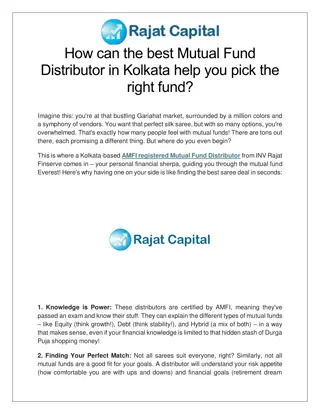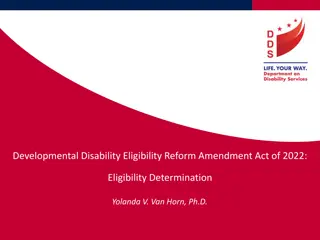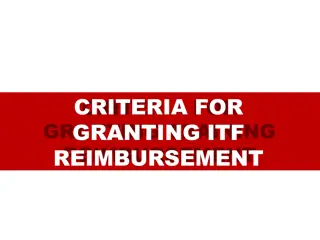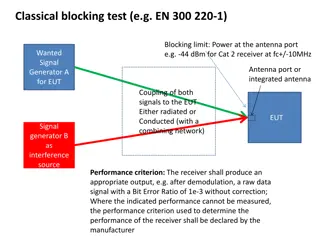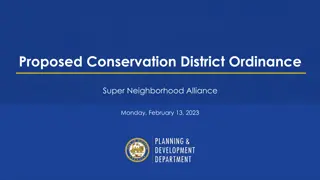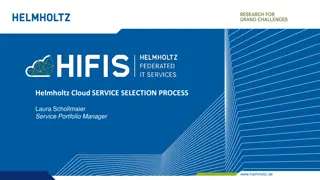
Project Evaluation and Decision Criteria in Finance
Explore the key concepts related to project evaluation in finance, including decision criteria like NPV, IRR, and Payback Rule. Learn about project categories, sources of project ideas, and how to assess project value creation. Dive into understanding cash flows, required returns, and the Net Present Value (NPV) of a project.
Download Presentation

Please find below an Image/Link to download the presentation.
The content on the website is provided AS IS for your information and personal use only. It may not be sold, licensed, or shared on other websites without obtaining consent from the author. If you encounter any issues during the download, it is possible that the publisher has removed the file from their server.
You are allowed to download the files provided on this website for personal or commercial use, subject to the condition that they are used lawfully. All files are the property of their respective owners.
The content on the website is provided AS IS for your information and personal use only. It may not be sold, licensed, or shared on other websites without obtaining consent from the author.
E N D
Presentation Transcript
1 P.V. VISWANATH FOR A FIRST COURSE IN FINANCE
2 What are the characteristics of good decision criteria? What is the NPV Rule? What is the Payback Rule? How is Accounting Rate of Return used for project selection? What is the IRR Rule? How do we use the IRR in the case of Mutually exclusive projects? How do we handle the case of multiple IRRs? How can we use the Profitability Index in situations of capital rationing ?
3 Three categories of projects: New Products Cost Reduction Replacement of Existing assets Sources of Project Ideas: Existing customers R&D Department Competition Employees P.V. Viswanath
4 We need to ask ourselves the following questions when evaluating decision criteria Does the decision rule adjust for the time value of money? Does the decision rule adjust for risk? Does the decision rule provide information on whether we are creating value for the firm? We will look at these questions for each one of our decision criteria. P.V. Viswanath
5 Suppose you are looking at a new project and you have estimated the following cash flows: Year 0: Cashflow (CF) = -165,000 Year 1: CF = 63,120; Net Income (NI) = 13,620 Year 2: CF = 70,800; NI = 3,300 Year 3: CF = 91,080; NI = 29,100 Average Book Value = 72,000 Your required return for assets of this risk level is 12%. How would you go about deciding whether to accept this project or not? Let s look at how the different decision criteria would go about it. Let s start with Net Present Value. P.V. Viswanath
6 The NPV of a project is essentially the difference between the market value of a project and its cost It answers the question: how much value is created from undertaking an project? The first step is to estimate the expected future cash flows. The second step is to estimate the required return for projects of this risk level. The third step is to find the present value of the cash flows and subtract the initial investment. P.V. Viswanath
7 If the NPV is positive, accept the project A positive NPV means that the project is expected to add value to the firm and will therefore increase the wealth of the owners. Since our goal is to increase owner wealth, NPV is a direct measure of how well this project will meet our goal. One advantage of NPV is that it is an additive measure: If there are two projects A and B, then NPV(A and B) = NPV(A) + NPV(B). P.V. Viswanath
8 Turning back to our project, we discount the cash flows at the required rate of return and find: NPV = 63,120/(1.12) + 70,800/(1.12)2 + 91,080/(1.12)3 165,000 = 12,627.42 Do we accept or reject the project? Since the NPV > 0, accepting the project would increase firm value by 12,627.42 and we accept the project. P.V. Viswanath
9 The NPV rule accounts for the time value of money. The NPV rule accounts for the risk of the cash flows. The NPV rule provides an indication about the increase in value. The NPV rule satisfies all our criteria for a good decision rule. P.V. Viswanath
10 A project requires an investment of $1000 and generates $1200 in two years time. The discount rate/cost of capital is 10% per annum. Does the project have a positive NPV? Yes No P.V. Viswanath
11 A project requires an investment of $1000 and has a payoff of $700 in year 1 and $400 in year 2. The cost of capital is zero. Does the project have a positive NPV? Yes No P.V. Viswanath
12 You know that the present value of a cashflow in five years of $200 is $185. You have an investment requiring an investment of $350 today, which will pay $400 in five years time. Does the project have an NPV>0? Yes No P.V. Viswanath
13 This is the most important alternative to NPV It is often used in practice and is intuitively appealing It is based entirely on the estimated cash flows and is independent of interest rates found elsewhere. Definition: IRR is the discount rate that makes the NPV = 0 Decision Rule: Accept the project if the IRR is greater than the required return P.V. Viswanath
14 Suppose you are looking at a new project and you have estimated the following cash flows: Year 0: Cashflow (CF) = -165,000 Year 1: CF = 63,120; Net Income (NI) = 13,620 Year 2: CF = 70,800; NI = 3,300 Year 3: CF = 91,080; NI = 29,100 Average Book Value = 72,000 Your required return for assets of this risk level is 12%. How would you go about deciding whether to accept this project or not using the IRR rule? P.V. Viswanath
If we compute the NPVs of the project at different discount rates, and plot them, we see that the IRR of this project is 16.13%. 70,000 60,000 IRR = 16.13% because NPV=0 at that discount rate. It is the point where the NPV profile cuts the X- axis. 50,000 40,000 30,000 NPV 20,000 10,000 0 0 0.02 0.04 0.06 0.08 0.1 0.12 0.14 0.16 0.18 0.2 0.22 -10,000 -20,000 Discount Rate P.V. Viswanath 15
16 If we do not have a financial calculator, then this becomes a trial and error process. However, financial calculators and spreadsheet programs usually have functions that compute the IRR. Excel, for example, has an IRR function. Do we accept or reject the project? Since the IRR of 16.13% is greater than the required rate of return of 12%, we accept the project. P.V. Viswanath
17 Knowing a return is intuitively appealing. It is a simple way to communicate the value of a project to someone who doesn t know all the estimation details. If the IRR is high enough, you may not need to estimate a required return, which is often a difficult task. Can be used to gauge sensitivity of project value to errors in estimation of the discount rate. P.V. Viswanath
18 NPV and IRR will generally give us the same decision Exceptions Non-conventional cash flows cash flow signs change more than once Mutually exclusive projects What do we do if there is a conflict? NPV directly measures the increase in value to the firm. Hence whenever there is a conflict between NPV and another decision rule, you should always use NPV. P.V. Viswanath
19 When the cash flows change sign more than once, there is more than one IRR When you solve for IRR you are solving for the root of an equation and when you cross the x-axis more than once, there will be more than one return that solves the equation If you have more than one IRR, which one do you use to make your decision? P.V. Viswanath
20 Suppose an investment will cost $90,000 initially and will generate the following cash flows: Year 1: 132,000 Year 2: 100,000 Year 3: -150,000 The required return is 15%. Should we accept or reject the project? Let us look at the NPV profile. P.V. Viswanath
IRR = 10.11% and 42.66% $4,000.00 $2,000.00 $0.00 0 0.05 0.1 0.15 0.2 0.25 0.3 0.35 0.4 0.45 0.5 0.55 ($2,000.00) NPV ($4,000.00) ($6,000.00) ($8,000.00) ($10,000.00) Discount Rate P.V. Viswanath 21
22 If you compute the NPV, you would find it is positive at a required return of 15%, so you should Accept If you compute the IRR using a calculator, you would probably get an IRR of 10.11% which would tell you to Reject What do you do, now? You need to recognize that there are non-conventional cash flows and look at the NPV profile. In this case, we see that there are two IRRs! In general, it can be shown that the correct IRR to use is one where the NPV Profile function is downward sloping. In this case, that would be 42.66%. However, this shows us that the right decision using IRR is not so easy! P.V. Viswanath
23 Mutually exclusive projects If you choose one, you can t choose the other Example: You can choose to attend graduate school next year at either Harvard or Stanford, but not both Intuitively you would use the following decision rules: NPV choose the project with the higher NPV IRR choose the project with the higher IRR But look at the following project P.V. Viswanath
The required return for both projects is 10%. Period Project A Project B 0 -500 -400 Which project should you accept and why? 1 325 325 2 325 200 The IRR rule says pick B, while the NPV rule says pick A! IRR 19.43% 22.17% NPV 64.05 60.74 P.V. Viswanath 24
25 One way to deal with this problem is to consider project B as accepted, tentatively, and then to ask if it s worthwhile switching to project A. Looking at the associated incremental cashflows, we see that it s better to switch. That is, A is better than B, which is what the NPV rule tell us. By looking at NPV profiles, we can see why the IRR rule behaves as it does. Period Project A Project B Switch from B to A 0 -500 -400 -100 1 325 325 0 2 325 200 125 IRR 19.43% 22.17% 11.8% NPV 64.05 60.74 3.30
$160.00 IRR for A = 19.43% $140.00 IRR for B = 22.17% $120.00 $100.00 Crossover Point = 11.8% $80.00 A B NPV $60.00 $40.00 $20.00 $0.00 0 0.05 0.1 0.15 0.2 0.25 0.3 ($20.00) ($40.00) Discount Rate IRR assumes reinvestment of positive cash flows during the project at the same calculated IRR. When positive cash flows cannot be reinvested back into the project, IRR overstates returns. That s why at low discount rates, the higher IRR project looks bad from an NPV standpoint. P.V. Viswanath 26
27 Suppose you have two mutually exclusive projects and the cost of capital is 10% p.a.: Project 0 1 2 IRR NPV A -800 650 375 20.24% $100.83 B -400 325 200 22.17% $60.74 We pick project A even though project B has a higher IRR. This is because the higher scale of project A promises higher overall rewards. P.V. Viswanath
28 Suppose you have two mutually exclusive projects and the cost of capital is 10% p.a. Project 0 1 2 IRR NPV A -800 1000 0 25.00% $109.09 B -800 0 1250 25.00% $233.06 Both projects have the same IRR and earn 25% p.a., but project B is preferable because it allows the firm to earn an excess of 15 percentage points over two years rather than one year (project A). P.V. Viswanath
29 The payback rule asks the question: how long does it take to get the initial cost back in a nominal sense? Computation Estimate the cash flows Subtract the future cash flows from the initial cost until the initial investment has been recovered Decision Rule Accept if the payback period is less than the preset limit P.V. Viswanath
30 Assume we will accept the project if it pays back within two years. Year 1: 165,000 63,120 = 101,880 still to recover Year 2: 101,880 70,800 = 31,080 still to recover Year 3: 31,080 91,080 = -60,000 The project pays back fully in year 3 Do we accept or reject the project? In this case, we reject the project because the payback is greater than two years. P.V. Viswanath
31 Disadvantages Ignores the time value of money Requires an arbitrary cutoff point Ignores cash flows beyond the cutoff date Biased against long-term projects, such as research and development, and new projects Advantages Easy to understand Adjusts for uncertainty of later cash flows Biased towards liquidity P.V. Viswanath
32 We usually assume that the same discount rate is applied to all cash flows. Let di be the discount factor for a cash flow at time i, implied by a constant discount rate, r, where di = 1/(1+r)i. Then di+1/di = 1+r, a constant. However, if the riskiness of successive cash flows is greater, then the ratio of discount factors would take into account the passage of time as well as this increased riskiness. In such a case, the discount factor may drop off to zero more quickly than if the discount rate were constant. Given the simplicity of the payback method, it may be appropriate in such a situation. P.V. Viswanath
33 Discount factor Discount factor function implied by the payback period rule Discount factor function implied by a constant discount rate True discount factor function 0 Timing of cash flow P.V. Viswanath
34 There are many different definitions for average accounting return (AAR). The one we use is: Average net income / average book value Note that the average book value depends on how the asset is depreciated. Need to have a target cutoff rate Decision Rule: Accept the project if the AAR is greater than a preset rate. P.V. Viswanath
35 Assume we require an average accounting return of 25%. Average Net Income: (13,620 + 3,300 + 29,100) / 3 = 15,340 AAR = 15,340 / 72,000 = .213 = 21.3% Do we accept or reject the project? In this case, we reject the project because its AAR is less than the cutoff of 25%. P.V. Viswanath
36 Advantages Easy to calculate Needed information will usually be available Disadvantages Not a true rate of return; time value of money is ignored Uses an arbitrary benchmark cutoff rate Based on accounting net income and book values, not cash flows and market values P.V. Viswanath
Summary Accept Net Present Value Reject Payback Period Reject Average Accounting Return Accept Internal Rate of Return P.V. Viswanath 37
38 Measures the benefit per unit cost, based on the time value of money It is computed as the NPV of the project divided by initial investment. A profitability index of 1.1 implies that for every $1 of investment, we create an additional $0.10 in value This measure can be very useful in situations where we have limited capital P.V. Viswanath
39 Advantages Closely related to NPV, generally leading to identical decisions Easy to understand and communicate May be useful when available investment funds are limited Disadvantages May lead to incorrect decisions in comparisons of mutually exclusive investments P.V. Viswanath
40 We should consider several investment criteria when making decisions NPV and IRR are the most commonly used primary investment criteria Payback is a commonly used secondary investment criteria; this may be because short paybacks allow firms to have funds sooner to invest in other projects without going to the capital markets Even though payback and AAR should not be used to make the final decision, we should consider the project very carefully if they suggest rejection. There may be more risk than we have considered or we may want to pay additional attention to our cash flow estimations. Sensitivity and scenario analysis can be used to help us evaluate our cash flows. From a logical point of view, NPV is best and should be used if possible. P.V. Viswanath





